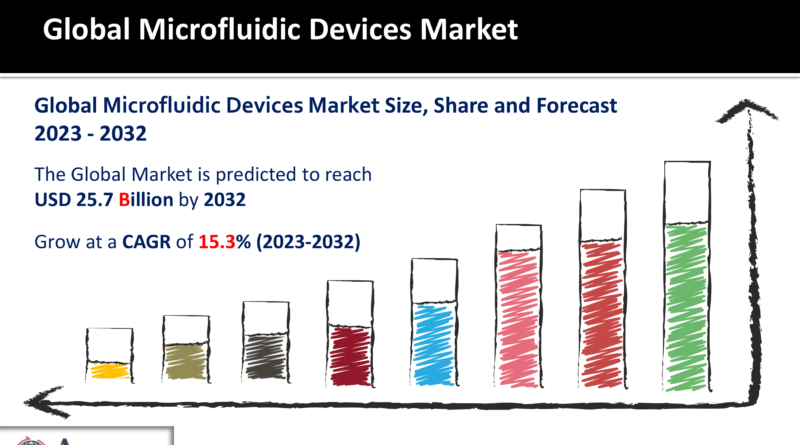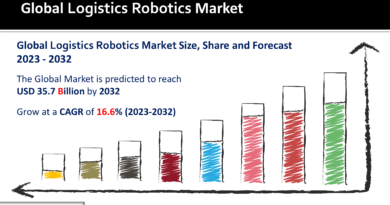Microfluidic Devices Market Size, Share, Growth Forecast 2023-2032
The Microfluidic Devices Market Size amounted to USD 6.4 Billion in 2022 and is anticipated to reach USD 25.7 Billion by 2032, with a CAGR of 15.3% from 2023 to 2032.
Introduction
The Microfluidic Devices Market has emerged as a dynamic and evolving industry, demonstrating robust growth prospects in recent years. As we delve into the intricacies of this field, we will explore the current market trends, drivers, restraints, opportunities, regional insights, competitive landscape, future growth prospects, and the key market players.
Download Free Microfluidic Devices Market Sample Report Here: (Including Full TOC, List of Tables & Figures, Chart)https://www.acumenresearchandconsulting.com/request-sample/2292
 Current Market Trends
Current Market Trends
Microfluidic devices are at the forefront of innovation, revolutionizing various industries. Some of the prevailing trends in the market include:
Lab-on-a-Chip Revolution: The development of lab-on-a-chip devices has gained immense traction. These miniaturized systems enable precise control over small volumes of fluids, leading to significant advancements in diagnostics, drug discovery, and personalized medicine.
Point-of-Care Testing (POCT): The growing demand for rapid and accessible diagnostic tools has led to the rise of POCT microfluidic devices. They are crucial in the detection and monitoring of diseases, including infectious diseases and chronic conditions.
Integration with AI and IoT: Microfluidic devices are increasingly being integrated with Artificial Intelligence (AI) and the Internet of Things (IoT) for real-time data analysis and remote monitoring. This integration enhances data accuracy and speeds up the decision-making process.
Market Drivers
Several factors are driving the growth of the Microfluidic Devices Market:
Increasing Healthcare Needs: The demand for precise, quick, and cost-effective diagnostic tools is escalating, particularly in emerging economies. Microfluidic devices offer a solution by enabling on-site diagnostics and monitoring.
Rising Focus on Drug Development: Pharmaceutical companies are turning to microfluidic devices for drug discovery and development due to their efficiency in screening, reducing costs, and accelerating the process.
Miniaturization: The need for miniaturization in various applications, including healthcare, electronics, and chemistry, is driving the adoption of microfluidic technology.
Market Restraints
While the Microfluidic Devices Market presents exciting opportunities, it is not without its challenges:
Complex Manufacturing: The fabrication and scaling of microfluidic devices can be complex and costly, limiting market growth.
Regulatory Challenges: The regulatory landscape for medical devices is stringent. Ensuring compliance with evolving regulations can be a hurdle for market players.
Opportunities
The Microfluidic Devices Market offers promising opportunities for investors and innovators:
Emerging Markets: Expanding into emerging economies with growing healthcare needs can be a lucrative opportunity for market expansion.
Diverse Applications: Microfluidic devices are not limited to healthcare; they find applications in various fields, including environmental monitoring, food testing, and biotechnology.
Regional Insights
The Microfluidic Devices Market is witnessing regional variations:
North America: The United States is a significant player, driven by its robust healthcare industry and investments in research and development.
Europe: The European market is characterized by a focus on research and innovation, with countries like Germany and the UK leading the way.
Asia-Pacific: This region exhibits immense growth potential, driven by the need for affordable healthcare solutions in densely populated countries like India and China.
Competitive Landscape
Key market players include:
Danaher Corporation: A global leader in microfluidic technologies, Danaher offers a wide range of innovative solutions in diagnostics and life sciences.
PerkinElmer Inc.: Known for its cutting-edge technologies, PerkinElmer is at the forefront of advancing microfluidic applications in healthcare.
Roche Diagnostics: With a strong focus on diagnostics, Roche Diagnostics plays a vital role in the market’s growth.
Future Growth Prospects
The future of the Microfluidic Devices Market is promising. As technology continues to advance and the need for miniaturization and efficiency grows, microfluidic devices are set to play a pivotal role in various industries. Key growth prospects include:
Customization: Tailoring microfluidic devices to meet specific industry needs, such as personalized medicine and niche applications.
Partnerships: Collaborations between microfluidic device manufacturers and healthcare providers will drive innovation and market expansion.
Research and Development: Ongoing research to simplify manufacturing processes and improve device scalability will open new opportunities.
Microfluidic Devices Market Players
Some of the top microfluidic devices companies offered in our report includes Abbott, Agilent, ALine, Inc., BioFluidix GmbH, Bio-Rad Laboratories, Blacktrace Holdings Ltd. (Dolomite Microuidic), Fluidigm Corporation, Fluigent, Johnson and Johnson, Micronit, Perkin Elmer, Philips, Roche, Siemens Healthcare, and uFluidix.
Get Discount On The Purchase Of This Report:https://www.acumenresearchandconsulting.com/buy-now/0/2292
Find more such market research reports on our website or contact us directly
Write to us at sales@acumenresearchandconsulting.com
Call us on +918983225533
or +13474743864


